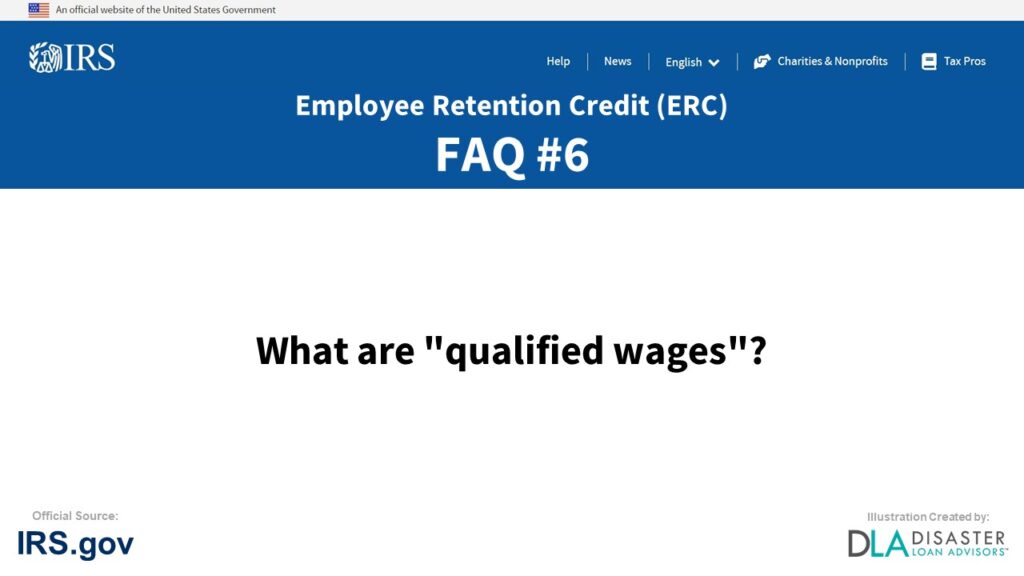
Frequently asked question #6 “What are qualified wages?” under the General Information section of FAQs: Employee Retention Credit under the CARES Act, provided by the IRS.gov to help business owners understand the ERC program. Information is below for the question #6 What are “qualified wages”?
ERC Credit Frequently Asked Question #6:
COVID-19-Related Employee Retention Credits:
General Information FAQs
6. What are “qualified wages”?
Qualified wages are wages (as defined in section 3121(a) of the Internal Revenue Code (the “Code”)) and compensation (as defined in section 3231(e) of the Code) paid by an Eligible Employer to some or all employees after March 12, 2020, and before January 1, 2021. Qualified wages include the Eligible Employer’s qualified health plan expenses that are properly allocable to the wages.
The definition of qualified wages depends, in part, on the average number of full-time employees (as defined in section 4980H of the Code) employed by the Eligible Employer during 2019.
If the Eligible Employer averaged more than 100 full-time employees in 2019, qualified wages are the wages paid to an employee for time that the employee is not providing services due to an economic hardship, specifically, either (1) a full or partial suspension of operations by order of a governmental authority due to COVID-19, or (2) a significant decline in gross receipts.
For these employers, qualified wages taken into account for an employee may not exceed what the employee would have been paid for working an equivalent duration during the 30 days immediately preceding the period of economic hardship described in (1) or (2) above.
If the Eligible Employer averaged 100 or fewer full-time employees in 2019, qualified wages are the wages paid to any employee during any period of economic hardship described in (1) or (2) above.
For more information, see Determining Qualified Wages.
For more Internal Revenue Service (IRS) Department of the Treasury Employee Retention Credit (ERC) General Information FAQs, visit the official IRS.gov tax website.
Conclusion and Summary on ERC Credit FAQ #6. What are “qualified wages”?
The “What are qualified wages?” is Frequently Asked Question #6 of many commonly asked questions small business owners are wondering about how to file the Employee Retention Tax Credit (ERTC). The IRS ERC Tax Credit program is a confusing and complex process to determine the correct ERC calculations your business qualifies for. Answers to “What are qualified wages?” and filling out form 941-X may change slightly from frequently updated rules and regulations from the IRS. Leave a comment below if you have further questions on ERC Credit FAQ #6.
Help Completing / Filing / Claiming the Employee Retention Credit (ERC)
Receive Up to a $26,000 ERC Credit from the IRS Per Employee
Disaster Loan Advisors can assist your business with the complex and confusing Employee Retention Credit (ERC), Form 941-X, and the Employee Retention Tax Credit (ERTC) program.
Depending on eligibility, business owners and companies can receive up to $26,000 per employee based on the number of W2 employees you had on the payroll in 2020 and 2021.
The ERC / ERTC Tax Credit Program is a valuable IRS tax credit you can claim. This is money you have already paid to the IRS in payroll taxes for your W2 employees.
We DO NOT charge a percentage (%) of your ERC Refund like some companies are charging. Some ERC firms out there are charging upwards of 15% to 35% of your ERC refund!
Our professional ERC fee and pricing structure is very reasonable in comparison.
If you are looking for an ERC Company that believes in providing professional ERC Services and value, in exchange for a fair, reasonable, and ethical fee for the amount of work required, Disaster Loan Advisors is a good fit for you.
Schedule Your Free Employee Retention Credit Consultation to see what amount of employee retention tax credit your company qualifies for.
Cover Image Credit: Irs.gov / ERC FAQ / Disaster Loan Advisors.
